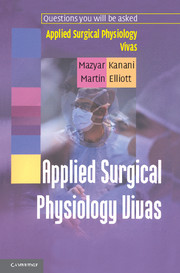Book contents
- Frontmatter
- Contents
- List of Abbreviations
- Dedication
- Preface
- A Change in Posture
- Acid-Base
- Action Potentials
- Adrenal Cortex I
- Adrenal Cortex II – Clinical Disorders
- Adrenal Medulla
- Arterial Pressure
- Autonomic Nervous System (ANS)
- Carbon Dioxide Transport
- Cardiac Cycle
- Cardiac Output (CO)
- Cell Signalling
- Cerebrospinal Fluid (CSF) and Cerebral Blood Flow
- Colon
- Control of Ventilation
- Coronary Circulation
- Fetal Circulation
- Glomerular Filtration and Renal Clearance
- Immobilization
- Liver
- Mechanics of Breathing I – Ventilation
- Mechanics of Breathing II – Respiratory Cycle
- Mechanics of Breathing III – Compliance and Elastance
- Mechanics of Breathing IV – Airway Resistance
- Microcirculation I
- Microcirculation II
- Micturition
- Motor Control
- Muscle I – Skeletal and Smooth Muscle
- Muscle II – Cardiac Muscle
- Nutrition: Basic Concepts
- Pancreas I – Endocrine Functions
- Pancreas II – Exocrine Functions
- Potassium Balance
- Proximal Tubule and Loop of Henle
- Pulmonary Blood Flow
- Renal Blood Flow (RBF)
- Respiratory Function Tests
- Small Intestine
- Sodium Balance
- Sodium and Water Balance
- Starvation
- Stomach I
- Stomach II – Applied Physiology
- Swallowing
- Synapses I – The Neuromuscular Junction (NMJ)
- Synapses II – Muscarinic Pharmacology
- Synapses III – Nicotinic Pharmacology
- Thyroid Gland
- Valsalva Manoeuvre
- Venous Pressure
- Ventilation/Perfusion Relationships
Microcirculation II
Published online by Cambridge University Press: 06 January 2010
- Frontmatter
- Contents
- List of Abbreviations
- Dedication
- Preface
- A Change in Posture
- Acid-Base
- Action Potentials
- Adrenal Cortex I
- Adrenal Cortex II – Clinical Disorders
- Adrenal Medulla
- Arterial Pressure
- Autonomic Nervous System (ANS)
- Carbon Dioxide Transport
- Cardiac Cycle
- Cardiac Output (CO)
- Cell Signalling
- Cerebrospinal Fluid (CSF) and Cerebral Blood Flow
- Colon
- Control of Ventilation
- Coronary Circulation
- Fetal Circulation
- Glomerular Filtration and Renal Clearance
- Immobilization
- Liver
- Mechanics of Breathing I – Ventilation
- Mechanics of Breathing II – Respiratory Cycle
- Mechanics of Breathing III – Compliance and Elastance
- Mechanics of Breathing IV – Airway Resistance
- Microcirculation I
- Microcirculation II
- Micturition
- Motor Control
- Muscle I – Skeletal and Smooth Muscle
- Muscle II – Cardiac Muscle
- Nutrition: Basic Concepts
- Pancreas I – Endocrine Functions
- Pancreas II – Exocrine Functions
- Potassium Balance
- Proximal Tubule and Loop of Henle
- Pulmonary Blood Flow
- Renal Blood Flow (RBF)
- Respiratory Function Tests
- Small Intestine
- Sodium Balance
- Sodium and Water Balance
- Starvation
- Stomach I
- Stomach II – Applied Physiology
- Swallowing
- Synapses I – The Neuromuscular Junction (NMJ)
- Synapses II – Muscarinic Pharmacology
- Synapses III – Nicotinic Pharmacology
- Thyroid Gland
- Valsalva Manoeuvre
- Venous Pressure
- Ventilation/Perfusion Relationships
Summary
1. What is oedema (edema)?
This is defined as the abnormal accumulation of fluid in the extravascular space.
2. What are two broad types, and how may they be distinguished?
Transudate: due to imbalances in the hydrostatic forces of the Starling equation
Exudate: occurs following an increase in the capillary permeability
The main difference (that can be used to aid diagnosis of the aetiology) is that an exudates is rich in protein and fibrinogen.
3. What are the main causes?
The main causes are categorised according to the variables in the Starling equation:
Reduced colloid osmotic pressure (πp): that occurs with hypoproteinaemic states, such as malnutrition, protein-losing enteropathy and the nephrotic syndrome
Increased capillary filtration pressure (Pc): as in cardiac failure where there is peripheral dependant oedema, ascites and pulmonary oedema. Most commonly, the main culprit is an elevation of the venous pressure, as in deep venous thrombosis. Increased filtration pressure also arises from abnormal retention of salt and water, e.g. renal failure an other causes of hypervolaemia
Increased capillary permeability: leading to the formation of an exudates – which follows an inflammatory process where there is an immune mediated increase in the capillary permeability
Lymphatic occlusion: leading to an accumulation of fluid in the interstitial compartment, e.g. malignant occlusion following lymphatic compression or lymphadenopathy
4. Apart from the increase in the capillary permeability, why else does inflammation promote oedema?
The vasodilatation associated with inflammation increases the capillary filtration pressure (i.e. there is a decrease in the pre-to-post capillary resistance ratio). As seen in Microcirculation I, the Pc is closely determined by the pre-to-post capillary resistance ratio.
- Type
- Chapter
- Information
- Applied Surgical Physiology Vivas , pp. 87 - 88Publisher: Cambridge University PressPrint publication year: 2004



